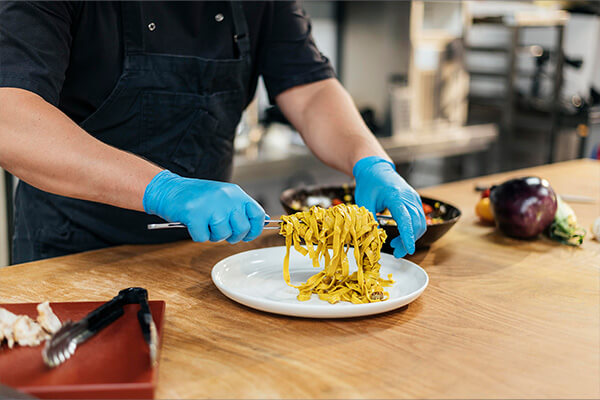Whether you're a professional chef, a home cook, or working in the catering industry, investing in the right food gloves is essential for maintaining cleanliness and preventing contamination. In this comprehensive guide, we'll explore everything you need to know about food gloves, including types, uses, and tips for choosing the best ones for your needs.
Disposable gloves are crucial in the catering industry. They protect the skin when cleaning and prevent contamination during food preparation tasks. However, selecting the right gloves for different tasks and ensuring your staff's requirements are met can be tricky. There are a variety of materials to choose from, such as vinyl, nitrile, and latex. Do you know which gloves are best for food preparation? What are the advantages of different materials?
Types of Food Prep Gloves
Food handling gloves are specifically designed for use in food preparation and handling tasks. They are often made from materials that comply with food safety regulations, ensuring that they do not contaminate the food.
Vinyl Gloves
-
Vinyl gloves are a popular choice for food handling due to their affordability and versatility.
-
They provide a comfortable fit and offer excellent tactile sensitivity, making them ideal for tasks that require dexterity.
-
Vinyl gloves are latex-free, making them suitable for individuals with latex allergies.
Nitrile Gloves
-
Nitrile gloves are designed for single-use applications, making them convenient for tasks that require frequent glove changes to maintain hygiene.
-
These gloves are available in various materials such as vinyl, nitrile, and latex, allowing users to choose based on their preferences and requirements.
-
Chemical resistant: Achieves type C chemical resistance according to EN ISO 374-1, for chemical protection against at least 1 chemical.
-
Conforms with the requirements of EN ISO 374-5, for protection against bacteria, fungi and virus.
Tips for Choosing the Right Food Gloves
Consider the Material
Choose gloves made from materials that are suitable for your specific needs, such as vinyl, nitrile, or latex. Ensure that the material is food-safe and free from harmful chemicals.
Assess the Fit
Proper fit is crucial for comfort and dexterity. Look for gloves that offer a snug yet comfortable fit to minimize the risk of tearing or slipping during use.
Check for Certification
When purchasing food gloves, look for certifications such as FDA approval or NSF certification, which indicate that the gloves meet industry standards for food safety.
Evaluate Thickness
The thickness of the gloves can impact their durability and tactile sensitivity. Thicker gloves may offer better protection against punctures and tears, while thinner gloves provide enhanced dexterity.
Consider Powder-Free Options
Powdered gloves may pose a risk of contamination, especially in food-handling environments. Opt for powder-free gloves to reduce the risk of allergic reactions and contamination.
Best Practices for Using Food Gloves
Proper Glove Use
Provide guidelines on when and how to wear food gloves during food preparation, cooking, and serving.
Glove Changing
Explain the importance of changing gloves between different tasks and when handling different food items.
Hand Hygiene
Stress the necessity of practising proper hand hygiene before and after wearing gloves.
Storage and Disposal
Offer tips on storing gloves properly to maintain their integrity and disposing of used gloves responsibly.
Investing in high-quality food gloves is essential for maintaining safety and hygiene standards in food preparation and handling. Whether you're cooking at home or working in a professional kitchen, choosing the right gloves can help prevent contamination and ensure the safety of both food and customers. By considering factors such as material, fit, and certification, you can select gloves that meet your specific needs and contribute to a safe and hygienic food handling environment.
Contact us today for advice on choosing the best food handling gloves!

